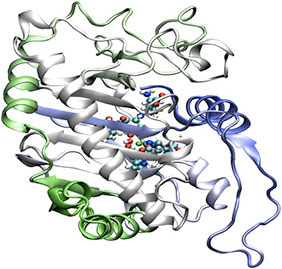Multi-scale models of enzymatic reactions

Enzymes catalyze many reactions both faster, and more selectively, than most man-made catalysts. If the mechanisms of enzyme catalysis could be understood, it could inspire the development of new efficient catalysts in many processes. We are especially interested in systems containing transition metals, because of they are involved in some of the most important biological reactions, photosynthesis and cell respiration.
Modeling is performed using both density functional theory (DFT) and multiconfigurational wavefunction methods. To improve the modeling of the protein surrounding, we use multi-scale models. Most commonly used is the combination of a quantum mechanics and a molecular mechanics method (QM/MM). We try to improve the description of the interactions between the QM and MM layer by designing QM/QM' models where QM’ is a relatively fast molecular orbital method that can describe charge transfer and mutual polarization between the reactive region and the protein surroundings. Another interesting method is to evaluate the MM contributions to catalysis using QM/MM-FEP methods (classical free energy perturbation).
We have applied these multi-scale methods on iron proteins, e.g., isopenicillin N synthase, involved in antibiotic synthesis, and 4-hydroxyphenylpyruvate dioxygenase, that performs biosynthesis of essential compounds for photosynthesis.
Project members: Nathalie Proos-Vedin, Marcus Lundberg
